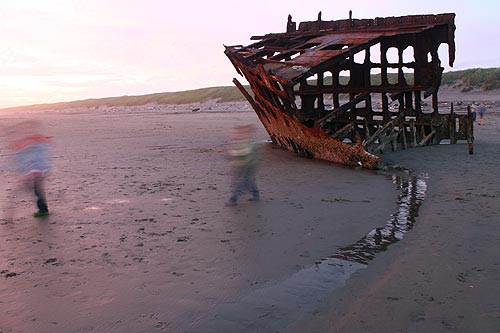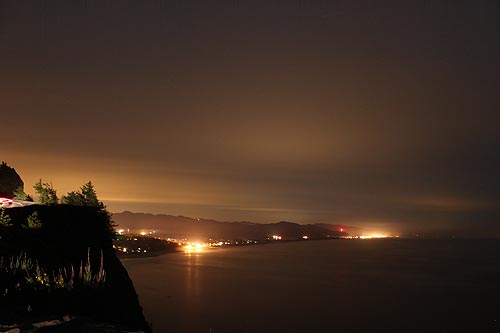 |
Oregon Coast First Day of Summer Ends with Green Flash, Shooting Stars, Glowing Sand
Published 06/21/2012

By Andre' Hagestedt
(Cannon Beach, Oregon) – No, it's not one of those cheapie bad flicks the Sy-Fy Network puts out these days, or another oddball paranormal hoax about the Oregon coast. It's real science – and not often seen. The longest day of the year on the Oregon coast did indeed cap itself off with the famed Green Flash at Sunset, then showed off shooting stars, glowing sand and even a massive Milky Way floating over the beach. It's like the trifecta of spectacular rarities for these beaches, except a few more thrown in.
Sunset conditions at the Wreck of the Peter Iredale at Warrenton are spectacular enough on this Wednesday, June 20. Big, fat puffy clouds make for bouncy sunlight and vibrant colors. This is always a kick in the pants. Then, just seconds before the sun's disc slips away completely, it gets that telltale green blob-ish formation around the edges. I'm shooting like a madman but in this moment of incredible glee I fire off the rock 'n roll horns of approval sign with my hand and scream “yeah!!!” as if I was at a rock concert. But who can blame me for losing composure?

Sadly, later I discover I didn't catch the Green Flash phenomenon at this moment. But you can see pics of what it looks like here. The green flash is a bit of a rarity around these parts. The short answer about the science behind it is: given the right conditions, the atmosphere cuts out all but the green wavelengths of the spectrum of the sun, leaving a sort of green outer rim to the sun or brief green blobs.
It should be noted I clocked the sunset at 9:10 p.m., which is 7 minutes later than the sunset time published for Portland. My cell phone time could've been off a bit, but this gels with the research I've been doing through various local scientists about how much later sunset happens on the coast than inland. More on this in the coming weeks.

Later, the wreck of the Iredale has this dreamlike quality to it after the sun has gone away.

As night fell on this part of the northern Oregon coast, it was time to explore the southern-most reaches of Cannon Beach, where this remarkable scene occurred. The star trail effect comes from a very long exposure.

Also, via a much shorter exposure, you could see the Milky Way in full, glorious form floating above Cannon Beach. This beach also surprised me with the stunning glowing sand effect: the result of tiny, bioluminescent creatures called dinoflagellates, which are a form of phytoplankton. They were faint, but they were there.
Look for the somewhat damp parts of the sand close to the tide line – but you'll need a very dark beach. You'll see tiny greenish/blue sparks beneath your feet as you shuffle them backwards.

A bit further up the road, it's my glorious friend, Neahkahnie Mountain, just above Manzanita. Here, the view is breathtaking at night as well as during the day, although by this time things got a bit cloudier. It's here I saw at least one shooting star.

Down on the ground, on Manzanita's beach, it's 3:30 a.m. and the dawn is starting to peek out. Glowing sand is seen here too, as well as another shooting star. The Big Dipper is looming above Neahkahnie here.
More About Cannon Beach Lodging.....
More About Cannon Beach Dining.....
 |
 |
LATEST OREGON COAST NEWS STORIES
Whale Body Parts Found on Oregon Coast - Two Whales Strand on Washington Coast |
Back to Oregon Coast
Contact Advertise on BeachConnection.net
All Content, unless otherwise attributed, copyright BeachConnection.net Unauthorized use or publication is not permitted
Secrets of the Season |
Unusual Travel Articles TravelParanormal.com allows you to submit your own creepy tale or debunk one - or see up-to-the-minute news headlines about travel and the paranormal. News Headlines from All Over Oregon Need to scan Oregon headlines? Constantly updated news from all over Oregon: a comprehensive, up-to-the-minute display of news headlines from a variety of media |





































